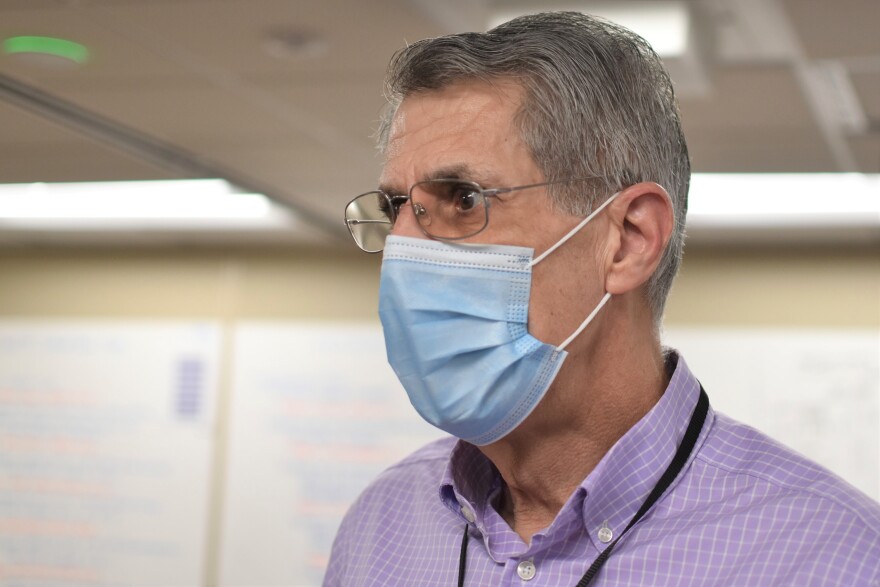Jeanne Bishop and Kathleen Marble are huddled together over their laptop and notes, quietly trying to figure out where they’re going to put all the kids and infants coming into Sparrow Hospital with COVID-19. It’s Tuesday, April 20, and the 8 a.m. incident command meeting has just wrapped. Now the real work begins.
“We haven't really seen it in the population until last week,” says Marble, the nursing director for pediatric services here at the Lansing hospital. Her eyes are tired, and she’s pushed her glasses on top of her head. “And now, our numbers are going up now in both [pediatrics] ICU and pediatrics.”
The youngest infant they’ve admitted is just two months old.

“The ones that are in ICU are needing respiratory support. They're on a ventilator just like the adults are. The ones that are in pediatrics are on a high flow [oxygen support].”
“And there's still kids that come in that we find out are COVID [positive], because we test them when they come into the hospital. And they're here for a broken leg, or they're here because they were in an auto accident. And then we find out they're positive.”
That's not unique to Sparrow. As of Friday, April 23, 54 children were hospitalized in Michigan with suspected or confirmed COVID (though Sparrow did see a decline in its pediatric admissions over the course of last week, a spokesperson said.) Just days earlier, the state hit a new record for pediatric COVID hospitalizations on April 20, according to the Michigan Health and Hospital Association: 70 inpatients under the age of 18.
That’s a 311% increase in pediatric admissions in just the last two months, says MHA spokesperson John Karasinski.
“The increase is likely due to a combination of factors," he said Friday via email. "The higher infection rates for children under the age of 18 ultimately leads to more children requiring inpatient care. The more contagious variants is likely driving the higher infection rates, along with exposure to unvaccinated adults and a resumption of activities at levels we have not seen previously during the pandemic, including sports, extracurricular activities, increased mobility and social gatherings.”
A year-plus marathon
These “incident command” meetings are a crisis measure Sparrow started during the spring surge last year. Back then, the meetings had an urgent, all-hands-on-deck feel, staffers say. Now, in the third surge, the tone is different.
“It was a big adrenaline rush in the beginning. You had the command center, ‘Oh, we’re here and we’re gonna help everybody!’” says Dr. Kenneth Thompson, a family medicine doctor. “Now it’s, ‘Oh, you’re only on mile number six. There are 20 to go.’ You’ve gotta be kidding. I sprinted the first six.”
On Tuesday, the day we spent at Sparrow, the hospital was at 100% capacity, with 50 overflow beds. Twelve people were waiting in the ER, and they were no longer going to admit any transfers from hospitals outside Sparrow’s health system, said Jeanne Bishop, the director of nursing operations.
There is, however, some potential good news: It looks like COVID cases have stopped their rapid climb and may be at a plateau, says Dr. Michael Zaroukian, the chief medical information officer and chief transformation officer. In the Lansing area, the positivity rate has fallen “below 16%...for the first time in weeks,” according to Sparrow’s own testing results.

Zaroukian’s hoping the recent decrease in new cases will stick.
“People are probably responding to what they’re seeing by being more cautious,” he says, nodding towards the whiteboards lining the walls, covered in notes about new admissions and changing protocols.
“I think it’s partly behavior, and partly the fact that some of the [social] mixing, like spring break, is over. And so they’re not doing as much traveling as they would have been doing during late March, early April. But I think the big aspect of it seems to have settled down. And so what’s also helping [is] our winter sports, which we think also was a bit of a vector, those seasons are over now. And so the next set of sports will be mostly outside and that should help as well.”
What worries him, though, is the possibility of hitting a vaccine wall: getting to a point where vaccine hesitancy keeps herd immunity out of reach. Given the spread of the B.1.1.7 variant, we’ll probably all need vaccine booster shots in six months to a year. But if COVID continues to circulate widely, it could make real progress hard.
“That's the biggest concern I have actually right now,” Dr. Zaroukian says. “The more [these variants] continue to spread and stay active, the more variants we’ll get…[and] the greater the chance that one of those variants will not respond to the vaccine. So that's why time is of the essence.”
“I’ve always been the caregiver”
From the command meeting, everyone disperses, headed back to their own departments. We take the elevator to the ninth floor, where Annette Cyphert is struggling to breathe.

The 63-year-old has been here for over a week now. Sitting up in bed, her bare feet hanging over the edge, Cyphert says COVID has made it hard to even talk to her children on the phone from her hospital room.
“I have to tell them to go away,” she says, managing a small chuckle between long, labored inhales from the nasal cannula pushing oxygen into her body. “I say, ‘I’ll call you back later when I can breathe.’”
Cyphert, who works in the bakery department at Walmart, says this experience is a role reversal. “I’ve always been the caregiver. And I can say that, because my daughter has extensive issues.” Now even small things, like going for walks – something that helps her anxiety – are no longer options.
She still manages to talk to her adult children on the phone every day, she says. And she thinks about the great-granddaughter on the way – her third. And just being able to sit up, or “hear my own voice,” that’s an improvement. But it’s an effort to get out even a few words at a time.
As we head out of Cyphert’s room and wish her well, I ask her: What made her agree to be interviewed? She’s in such a vulnerable position: sick, fighting to breathe, wearing only a thin gown, while the reporter and photographers are dressed in head-to-toe PPE and specialized oxygen hoods, like we’re handling toxic specimens.
“It’s lonely here!” Cyphert says. “That’s the main reason.” She just wanted to see people. “I’ve got three faces in here now,” she says, nodding at us.
“I was so close” to getting vaccinated
Quinita Glynn’s room is just a few doors down. The 42-year-old has spent the last 13 days here, and nurses say her remarkable improvement is a morale boost for the whole floor. When Glynn was admitted, she needed so much oxygen that she had to have a special feeding tube, so as not to remove her oxygen mask even briefly.
Now it looks like Glynn will soon be able to go home to her four kids, albeit with an oxygen machine.
“I’m feeling 100% better,” she says. “When I came in here about 13 days ago. My body just felt beat.”

Glynn has asthma. She knew COVID could be life-threatening for her, so she’s been extremely cautious over the last year, basically only leaving the house when it was absolutely necessary.
Just last month, she went in for a check-up with her pulmonologist, who said her lungs looked great. She’s not sure how she contracted the virus – possibly her youngest daughter, a 6th grader, brought it home from school.
But what Glynn initially assumed was a sinus infection just wouldn’t go away. One afternoon, her sister made her go to the emergency room, because Glynn was increasingly disoriented. That’s when she started deteriorating, fast, and was rushed to intensive care. During those first few days, she thought she was dying. But she fought hard, she says.
“And I been calling COVID ‘devil.’ I’m not gonna let the devil defeat me. You know, it’s bigger than this. I'm going to get out of here. Now … I got a testimony. This is part of my testimony. This is part of my story.”
But she can’t help but think how she got sick just days away from getting vaccinated.
“I was so close, you know? I fought the fight. I'm determined, you know, waiting for April 5. And here come COVID. And so I tried to push it and quarantine it. I just almost made it.”
For healthcare workers, the marathon keeps going
Out in the hallway, Dr. Kenneth Thompson is doing rounds with a resident. He’s been trying to keep the mood light, he says, and the nurses affectionately roll their eyes at his jokes about a box of gloves that “only have left hands! Must have been a discount.”
But everyone is exhausted. Just a couple months ago, Thompson and his team lost one of their own: Dr. Enrique Lopez, 67, another family medicine physician, died of COVID-19 complications on February 5.
“He was a good friend,” Thomspon says. “[He] picked it up in his office.” Dr. Lopez’s wife works at Sparrow too, Thompson says. “She’s been here 33 years. I just saw her the other day. She’s still working, because she says ‘If I don’t work, I’ll just sit at home and cry.’”
Thompson is silent a moment. Then a resident pokes her head out of a patient’s room, waving him over. “Gotta go be a hero,” he jokes, walking off. “Alright, you guys. Have fun. Wear a mask. Save a life.”
The Detroit Free Press, Bridge Michigan and Michigan Radio have teamed up to report on Michigan hospitals during the coronavirus pandemic. If you work in a Michigan hospital, we would love to hear from you. You can contact Kristen Jordan Shamus at kshamus@freepress.com, Robin Erb at rerb@bridgemi.com or Kate Wells at katwells@umich.edu.
Want to support reporting like this? Consider making a gift to Michigan Radio today.







